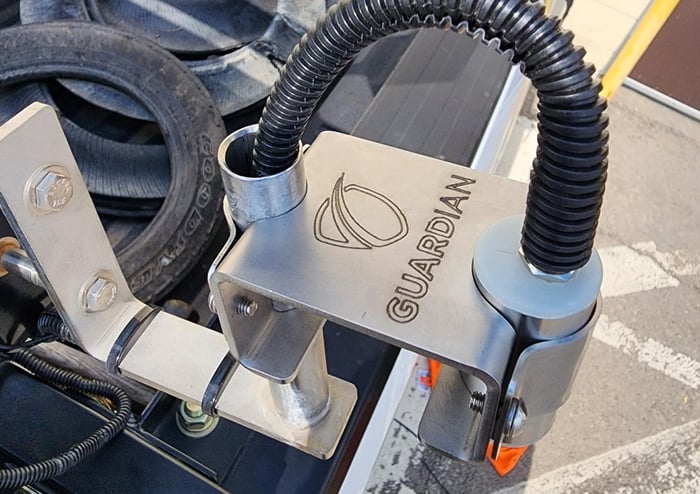.png?length=700&name=image%20(256).png)
Table of Contents
Every day workers across Canada risk falling victim to life-threatening electrical hazards while on the job.
In Ontario, between 2012 and 2021, 29 workers were unable to return home as a result of these dangers. The worst part? Each and every one of these deaths could have been prevented.
Electrocutions are part of OSHA’s “Fatal Four” construction site hazards—the same list that includes falls and struck-bys—yet they often get overlooked. But the truth is, that electrocutions are a serious threat to your vehicle fleets. They occur when a person is exposed to a lethal amount of energy, usually in the form of electricity. Exposure to this energy can result in a range of injuries– from brain damage and dislocations to respiratory arrest, and in severe cases, death.
Today we’ll discuss the significant threat electrical hazards pose to your vehicle fleet and how DiCAN’s patented award-winning Good to Go™ Box Alarm can help.
Understanding the Risk of Electrical Hazards
Occupational electrical-related hazards are a specific risk to those routinely working near electrical sources. An electrical hazard can be anything that exposes a worker to burns, electrocution, shock, arc flash/arc blast, fire and explosions.
According to the U.S. Bureau of Labor Statistics, there were 126 fatal electrical injuries in the U.S. in 2020 alone and the mining industry, followed by construction, demonstrated the highest rate of fatal electrical injuries.
Analyzing these accidents over the years has led to the identification of several determinants. In Ontario, a study among construction workers found that electrical contact was responsible for 15 percent of all fatalities. The study also cited direct contact with electrical sources, lower voltage sources and working outdoors as being directly correlated with occupational electrical-related fatalities, (Kim et al., 2016).
Watch out - Powerline Electrocutions are on the Rise
Over the past five years, the average rate of electrical fatalities has decreased by 3 percent. This is a significant accomplishment, but it doesn't mean that we can rest on our laurels. In fact, there's still much work to be done.
In comparing reports from 2012 and 2016 to 2017 and 2021, the rate of powerline fatalities has increased. During this short period of just four years, there was shown to be a 25 percent increase in power line electrocutions.
In fact, contact with overhead power lines is cited as the most frequent cause of fatal occupational electrocution injury, (Taylor et al., 2002). And unless we take action, this will remain.
Electrical Hazards Among Dump Trucks & Utility Vehicles
If you work in the construction, manufacturing or utility industries, you may be at a higher risk of electrocution than the average person.
According to Ontario’s latest Electrical Safety Report, the largest percentage of electrocution deaths occur among utility workers and those working in the construction and manufacturing sectors.
The threat is especially high for utility workers, who are at great risk given the dangerous amounts of power or energy carried by their equipment. In fact, utility-related deaths accounted for almost half (47 percent) of all electrical-related fatalities in the past ten years.
But it’s not just utility vehicles that are at risk. Given the nature of their work, dump trucks too, are at an increased risk of striking high-voltage power lines that run overhead.
In the construction industry, dump trucks are cited as the number one cause of powerline contact, and the biggest risk occurs when unloading.
Fortunately, there are several safety measures you can enlist to avoid these dangers– no matter your vehicle fleet!
Protect Your Vehicle Fleet With DiCAN’s Good to Go™
When it comes to electrical safety, you have to be prepared for anything. And with DiCAN’s Good to Go™ Alarm, you can be!
The first of its kind, the innovative microprocessor continuously monitors and alerts the unsafe positioning of any extendable component– from dump truck boxes to lift buckets, booms and more.
Good to Go™ will provide an audible and visual warning to alert operators in any situation where the extended component (arm, box, bucket) is not in its nested position. This can help prevent vehicles getting too close to overhead power lines or other potential hazards.
Since its inception in 2012, the ground-breaking safety system has become the most relied-up box-up alarm chosen by fleet managers, especially for dump trucks. Utilizing magnetic reed switches constructed of nylon-glass-filled polymer, potted and sealed, the safety device is able to provide a reliable, precise and maintenance-free solution.
With the Good to Go, you can feel confident your vehicle fleets are operating in the safest and most efficient way possible.
7 Benefits of the Good to Go™
- Depended Upon By Fleet Managers
Good to Go™ is a cross-industry solution that fleet managers depend on.
Utilizing tough, tamper-proof magnetic reed switches, this safety device is resistant to physical damage caused by dirt, ice and snow, or failures common with other mechanical micro switches, hydraulic pressure switches, proximity sensors, or electro-optical sensors.
- Highway Safety Code Compliant
At DiCAN, we create safety systems that are highway safety code compliant, and the Good to Go™ is no exception.
All advanced features of the device are guaranteed to meet the Highway Safety Code (chapter C24.2) SAAQ Tipper Truck Regulations in effect September 1, 2020.
- Audible, Visible, Speed Alarms & Continuous Position Monitoring
With the Good to Go™, the extendable component position is monitored in real-time, ensuring utmost accuracy. A 2-stage light + sound alarm is configured to emit pulsed and continuous signals based on vehicle speed and extendable component position.
Every time the vehicle starts automatic self-diagnostics will also begin. The constant 12-volt output can be connected to any internal or external warning device, including onboard AVL/GPS device.
- Hardwired Installation
Thanks to the warning systems hardwired installation, there is no potential for accidental or deliberate disconnection– ensuring your fleet of drivers is always protected.
In the event that a signal is lost, or the hardware is compromised, the system will immediately activate the visual and audible alarms. These alarms cannot be reset until the cause of the alerts has been resolved.
- Awarded for Safety
There’s no shortage of alarm solutions on the market. But just because they’re on the shelves doesn’t mean they’re reliable. Trust our award-winning solution!
Years ago one of our customers, The Corporation of the City of Timmins, was awarded for their efforts in powerline safety by the Canadian Electrical Safety Authority. They had identified a safety issue with their snow removal dump trucks and took immediate action with DiCAN’s Good to GO™ system to reduce the risk of powerline contact.
The City of Timmins has installed box buzzers on all city-owned dump trucks, and contractors hired for snow removal are required to have a box buzzer system in their trucks as well.
- Tailored to your fleet
The Good to Go™ is a highly configurable device, allowing you to fine-tune it to your specific needs.
Set speed control warnings, choose different frequencies of light flashes, schedule mute time, and more!
- Two options, one world-class solution
From small and large dump trucks to roll-off container trucks and excavator buckets, Good to Go™ is the industry standard– for all industries. Given the wide-ranging industries the product is able to serve, the warning system is offered in two options: Good to Go™ Basic and Good to Go™ Elite.
Good to Go™ Basic is a stand-alone system that provides single-component monitoring and audible as well as visual alerts. In contrast, Good to Go™ Elite takes data port connections, monitors up to 2 components and offers speed sensing in addition to audible and visual alerts.
Defend against Overhead Powerlines With Good to Go™
The chance of an extendable component becoming entangled in overhead power lines is higher than ever. If you're using an extendable component, it's important to be aware of the risks and take preventative measures.
Don't wait until it's too late—take action now. Contact us today to learn more about DiCAN's Good to Go™.





.png?length=700&name=image%20(207).png)